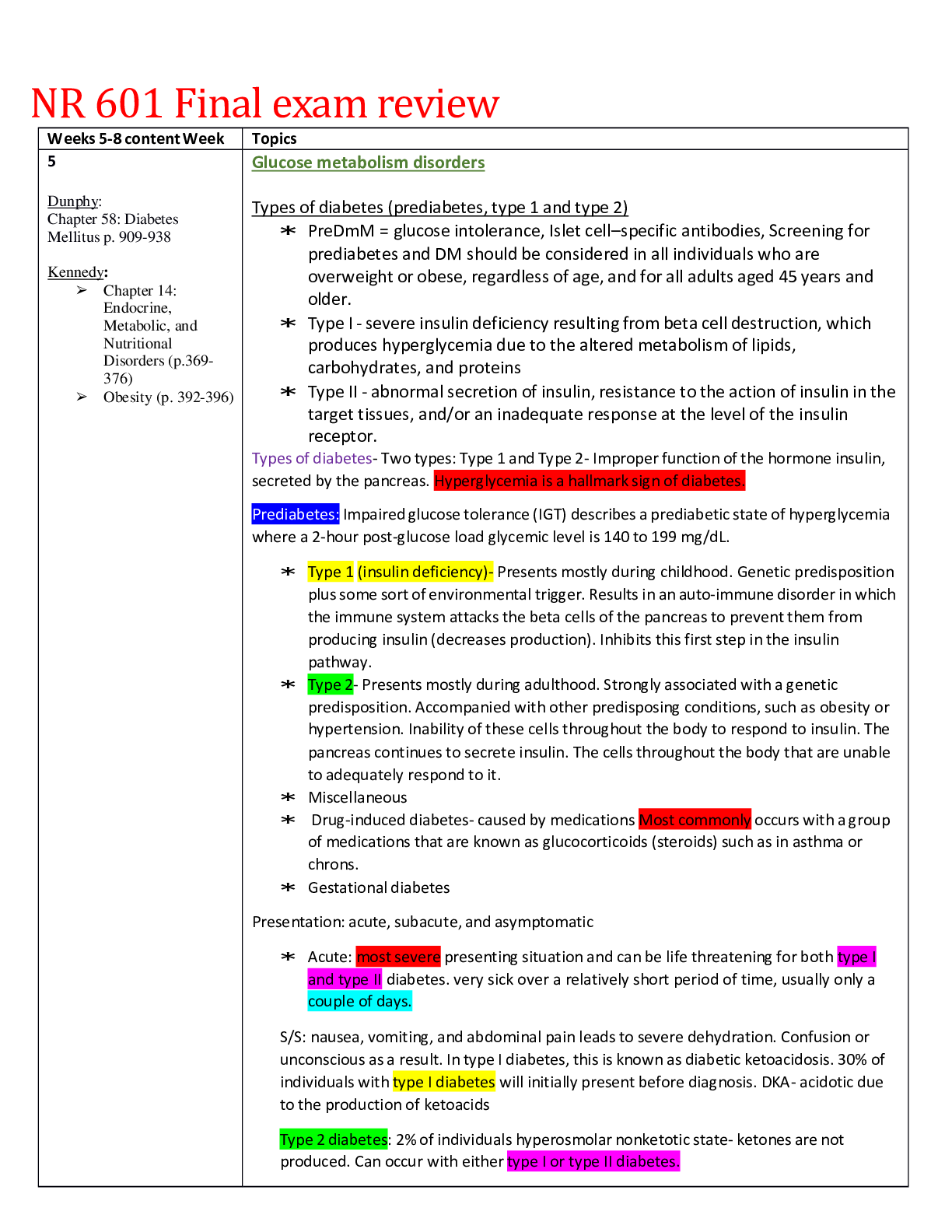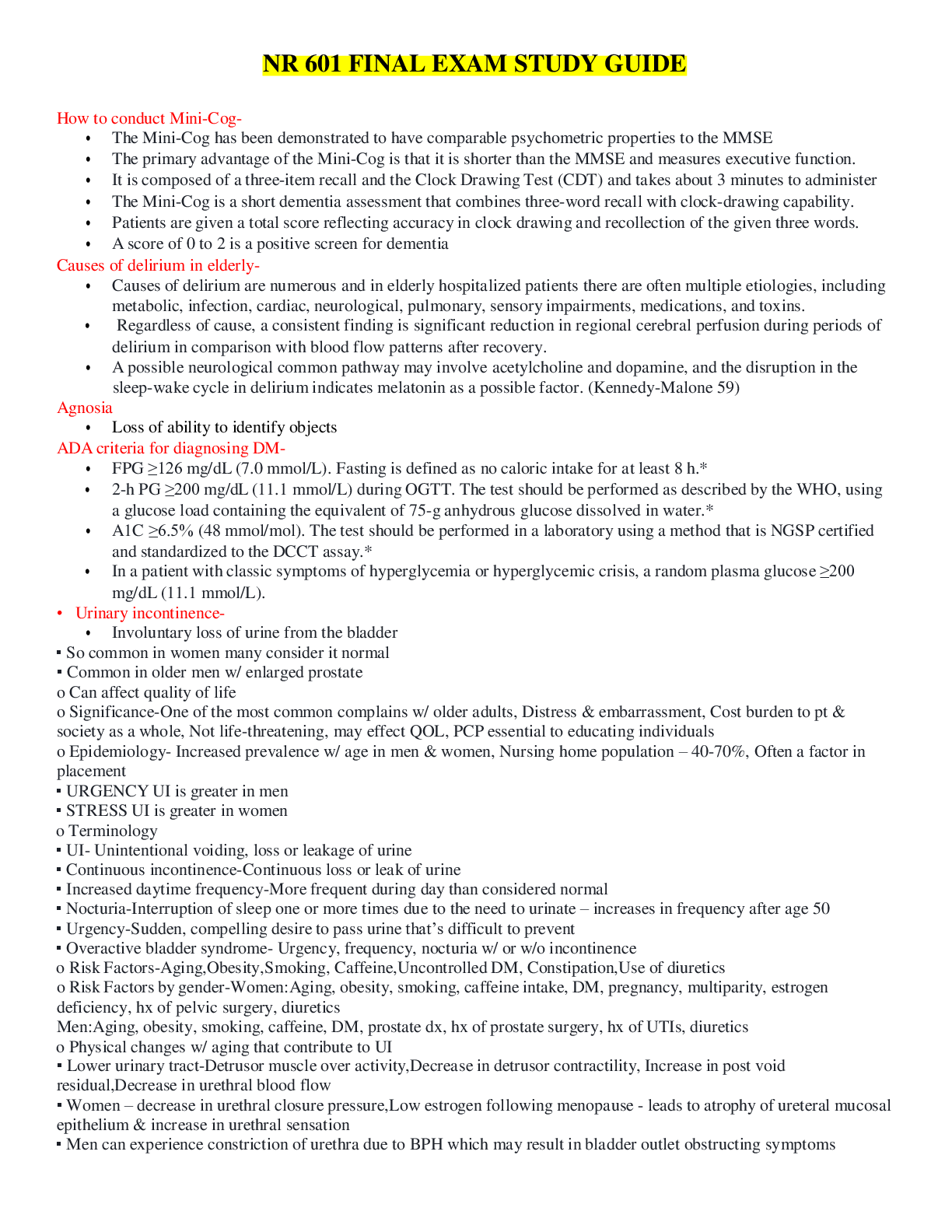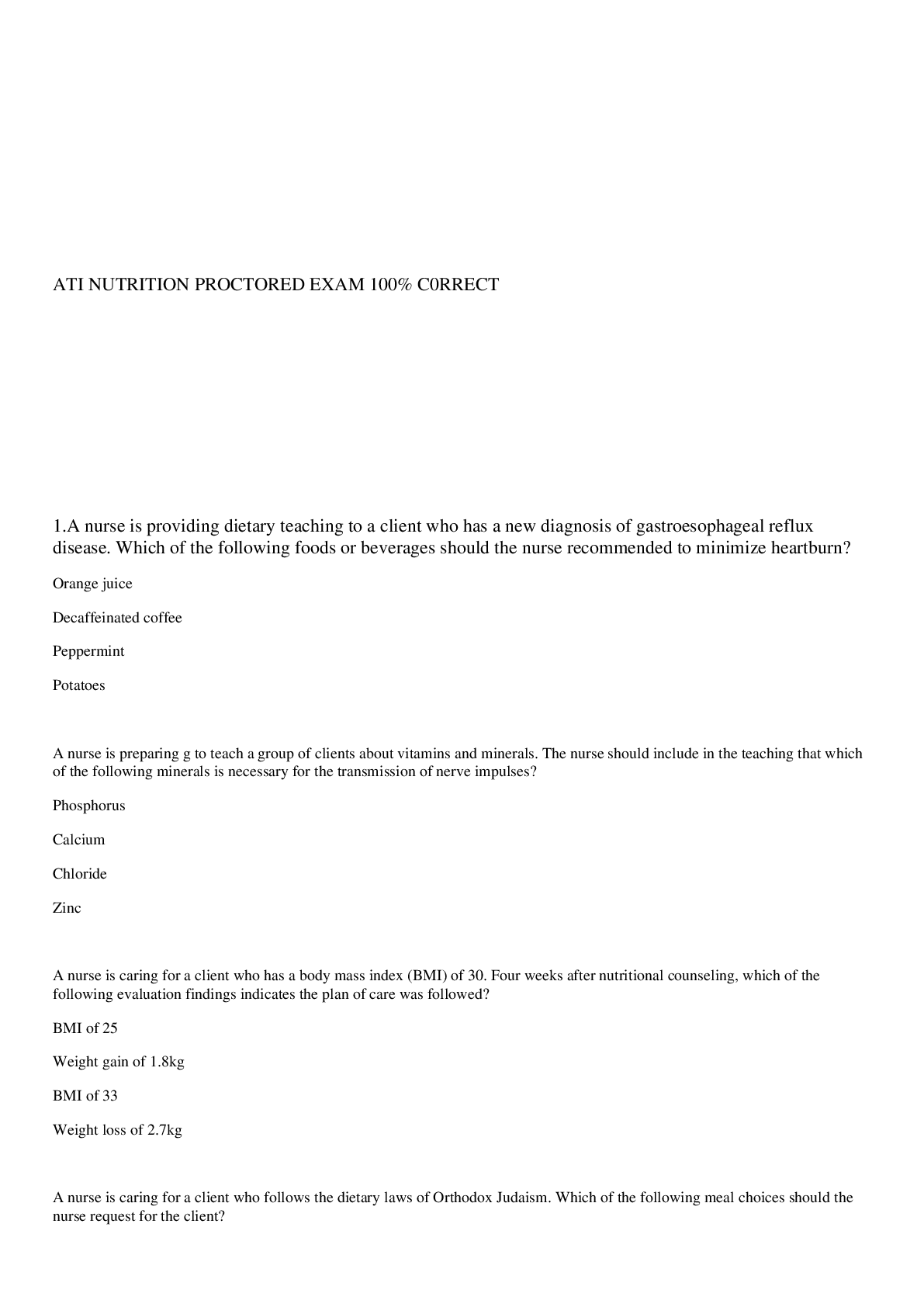*NURSING > Final Exam Review > Chamberlain College of Nursing NR 283 Patho Final Exam Concept Review. (All)
Chamberlain College of Nursing NR 283 Patho Final Exam Concept Review.
Document Content and Description Below
NR 283 Pathophysiology Final Exam Concept Review ***For all previous content covered on previous exams, please consult your previous concept review sheets. This is not an all-inclusive list for top... ics to be covered. Please be sure to consult your syllabus and learning plan. This is a comprehensive final. ***Be sure to cover pathophysiology, etiology, clinical manifestations, nursing considerations, diagnostic tests for the following topics: Endocrine SIADH- Syndrome of Inappropriate Diuretic Hormone Too much ADH (antidiuretic hormone ) secretion leads to water intoxication and hyponatremia Causes include trauma, stroke, malignancies (often in the lungs or pancreas), medications, and stress S/S include signs of fluid volume overload, changes in level of consciousness and mental status changes, weight gain, hypertension, tachycardia, anorexia, nausea, vomiting, hyponatremia, concentrated urine, decreased urine output, serum osmolality decreased Nursing considerations include monitoring vital signs and cardiac and neurological status, providing a safe environment, particularly for the patient with changes in level of consciousness or mental status, monitoring intake and output and weight daily; monitoring fluid and electrolyte balance, monitoring serum and urine osmolality; restriction of fluids DI (Diabetes Insipidus)- Kidney tubules fail to reabsorb water Etiology includes stroke or trauma or may be idiopathic S/S include excretion of large amounts of dilute urine, polydipsia, dehydration (decreased skin turgor and dry mucous membranes), inability to concentrate urine, increased urine output, urine very dilute, Low urinary specific gravity, fatigue, muscle pain and weakness, headache, postural hypotension that may progress to vascular collapse without rehydration, tachycardia, hypernatremia Nursing Considerations: monitor vital signs and neurological and cardiovascular status, provide a safe environment, particularly for the patient with postural hypotension; monitor electrolyte levels and for signs of dehydration; maintain patient intake of adequate fluids; monitor intake and ouput, weight, serum osmolality and specific gravity of urine; instruct the patient to avoid foods and/or liquids that produce diuresis Hyperthyroidism- Too much thyroid hormone (T3 and T4) Characterized by an increased rate of body metabolism Common cause is Graves’ disease, also known as toxic diffuse goiter S/S include: personality changes such as irritability, agitation and mood swings, nervousness and fine tremors of the hands, heat intolerance, weight loss, smooth, soft skin and hair, palpitations, cardiac dysrhythmias such as tachycardia or atrial fibrillation, diarrhea, protruding eyeballs (exophthalmos) may be present, diaphoresis (sweating), hypertension, enlarged thyroid gland (goiter) Nursing Considerations: Provide adequate rest, provide a cool and quiet environment, provide a highcalorie diet, obtain daily weight, avoid administration of stimulants, administer sedatives as prescribed, administer antithyroid medications, administer blood pressure medication for tachycardia, prepare for thyroidectomy if prescribed Hypothyroidism- Hyposecretion of thyroid hormones (T3 and T4) Characterized by a decreased rate of body metabolism Causes: autoimmune disease, treatment for hyperthyroidism, radiation therapy, thyroid surgery, certain medications S/S: lethargy, fatigue, weakness, muscle aches, paresthesias, intolerance to cold, weight gain, dry skin and hair and loss of body hair, bradycardia, constipation, generalized puffiness and edema around the eyes and face (myxedema), forgetfulness and loss of memory, menstrual disturbances, cardiac enlargement, tendency to develop heart failure, goiter may or may not be present Hyperparathyroidism- Hypersecretion of parathyroid hormone (PTH) Causes: Tumor, Hyperplasia, Genetics; secondary causes-severe calcium or vitamin D deficiency, chronic kidney failure S/S: Hypercalcemia and hypophosphatemia, fatigue and muscle weakness, skeletal pain and tenderness, bone deformities that result in pathological fractures, anorexia, nausea, vomiting, epigastric pain, weight loss, constipation, hypertension, cardiac dysrhythmias, renal stones Nursing Considerations: Monitor vital signs, particularly blood pressure; monitor for cardiac dysrhythmias, monitor for intake and output and for signs of renal stones, monitor skeletal pain, move the patient slowly and carefully; encourage fluid intake, administer furosemide (Lasix) as prescribed to lower calcium levels, administer phosphates, which interfere with calcium reabsorption as prescribed, administer calcitonin as prescribed to decrease the skeletal calcium release and increase renal excretion of calcium, monitor calcium and phosphorus levels, prepare the patient for parathyroidectomy as prescribed Hypoparathyroidism-Hyposecretion of parathyroid hormone (PTH) Can occur following a thyroidectomy because of removal of parathyroid tissue S/S: Hypocalcemia and hyperphosphatemia, numbness and tingling in the face, muscle cramps and cramps in the abdomen or extremities, positive Trousseau’s and Chvostek’s sign, signs of overt tetany such as bronchospasm, laryngospasm, carpopedal spasm, dysphagia, photophobia, cardiac dysrhythmias, seizures; hypotension, anxiety, irritability, depression Nursing Considerations: Monitor vital signs, monitor for signs of hypocalcemia and tetany, initiate seizure precautions, place a tracheostomy set, oxygen and suctioning equipment at bedside, prepare to administer calcium gluconate intravenously for hypocalcemia, provide a high-calcium, low-phosphorus diet, instruct the patient on administration of calcium supplements as prescribed, instruct the patient on administration of vitamin D supplements as prescribed, vitamin D enhances the absorption of calcium from the GI tract, instruct the patient on administration of phosphate binders as prescribed to promote the excretion of phosphate through the gastrointestinal tract, instruct to wear a Medic-Alert bracelet [Show More]
Last updated: 2 years ago
Preview 1 out of 26 pages
.png)
Buy this document to get the full access instantly
Instant Download Access after purchase
Buy NowInstant download
We Accept:

Reviews( 0 )
$15.00
Can't find what you want? Try our AI powered Search
Document information
Connected school, study & course
About the document
Uploaded On
Oct 04, 2021
Number of pages
26
Written in
Additional information
This document has been written for:
Uploaded
Oct 04, 2021
Downloads
0
Views
139



.png)
.png)


.png)
.png)






